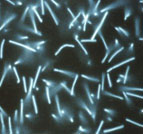




The domain Archae had long been thought to exist by some microbiologists. They are similar in many respects to bacteria in that they are prokaryotes and by past convention they were classified amongst bacteria. As long ago as 1977, however, Dr Carl Woese suggested that the archaea were fundamentally different from bacteria and proposed that they constituted what he referred to as a separate and distinct domain of living organisms. In 1996 this view was generally accepted. Some microbiologists suggest that the archaea domain sits between that of the prokaryotes and that of the eukaryotes, but the current main-stream view is as shown below, which is based on ribosomal DNA analysis.

Archaea
differ from bacteria primarily in that their cell wall does not contain
a component called peptidoglycan.
The plasma membranes in Archaea are different from those found in other
organisms and are made from lipid-like
materials. As with prokaryotes the genetic strands - DNA
- of archaea float freely in the cell. The RNA polymerase and ribosomal
proteins, however, are similar to that of eurkaryotes.
 |
 |
| Two views of archaea methanopyrus © University of Regensburg | |
Many Archaea live in extreme conditions and this has led to the name "extremophile" being given to them. According to Dr Carl Woese, there are four main types of archaea. Two can live in very hostile environments, such as salt lakes, hot springs, or in mid-ocean thermal vents. Another can metabolize chemicals that we would consider dangerous, or at least unpleasant, and makes methane as a by-product. While the last type lives by reducing sulfates. Others can use simple elementary chemicals such as hydrogen and sulfur.
Some biologists and planetary scientists now think that if life is discovered elsewhere in the Solar System it will probably resemble the archaea kingdom.
Go
to
Home
| Space Station
| Mars | Rainforest
© 1999 Satellite Events Enterprises Inc.